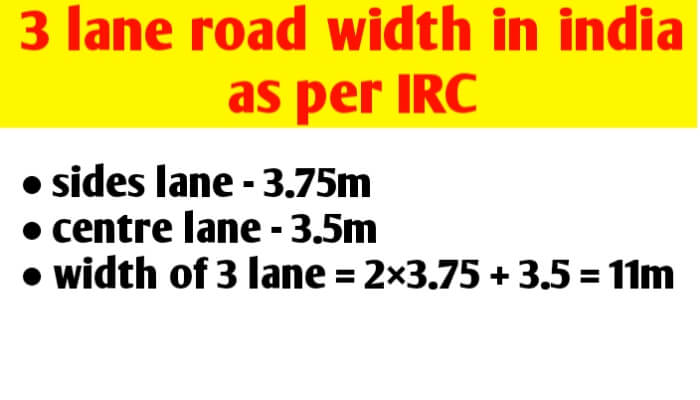The width of a 3-lane road in India, as per the Indian Road Congress (IRC) guidelines, typically ranges from 10.5 meters to 12 meters. This width allows for the safe movement of vehicles in three lanes, including the necessary space for lanes, shoulders, and medians. Please note that specific road design requirements may vary depending on factors such as traffic volume, terrain, and urban or rural settings.
Road construction department in India have set up Indian Road Congress (IRC). The Indian Roads Congress (IRC) is the Apex Body of Highway Engineers in the country give the guidelines, rule and regulation of several kinds of roads contraction. It is updated several times with new guidelines. In India, all matters related to Geometric design and structure are handle according to to IRC (Indian Road Congress).

There is several kinds of Road in india constructed by central and state government in urban and rural areas, such as National Highway (NH), state highway (SH), major district road (MDR), other District road & (ODR). It will be constructed in plain or mountainous steep & hilly area.
3 lane road or three-lane road is a road that permits two-way travel & traffics, usually it has no median barrier, one lane used for coming and other is used for going and sides lane is used for stoppage and parking. Three lane consist of two side carriageway width of 3.75m wide and centre lane is 3.5m wide. It is wide enough to allow all types of vehicles to pass one another.
The distance between passing places varies considerably, depending on the terrain and the volume of traffic on the road. A 3 lane road consists of two main component carriageway (three lane) for travelling & traffic and shoulder for vehicles to stop and accommodation.
Width of a three lane road consist of carriageway width & margin width. Width of margin comprises width of pavement shoulder and unpaved shoulder. A carriageway generally consists of a number of traffic lanes together with any associated shoulder. Road margin is the portion of road beyond the carriageway.
Shoulder are provided along the road edge and on intended for accommodation of stop vehicles, serve as an emergency lane for vehicles and provide lateral support. Shoulder should be strong enough to bear the weight of fully loaded truck even in wet condition. Shoulder width should be required for giving working space, ideal width of shoulder should be 4.6 m and minimum is about 2.5 m. Width of shoulder also depending on available space and elevation of surface such as plain, mountainous, steep or hilly area. In Mountain area it is quite difficult to construct a road so width of shoulder is minimised and their width is less than in plain area.
Carriageway width or width of pavement on which vehicles are going on depending on the width of traffic Lane and number of lane. Width of the traffic Lane depending on the width of the vehicles and the side clearance. Side clearance improve the operating speed and safety for vehicles.
As per IRC the maximum permissible width of a vehicle is 2.44m is allowed and desirable side clearance for two Lane road is about 0.53m on both sides and Centre clearance is about 1.06 meter. This require minimum of lane width 3.5m, so for a three Lane Road without kerb it will be 10.5m wide and with kerb it will require 11m meter wide.
◆You Can Follow me on Facebook and
Subscribe our Youtube Channel
3 lane road width in India as per IRC
In India, as per IRC rules and guideline, width of a 3 or three or triple Lane Road for carriageway is kept around 11 meter wide without kerb & with kerb it will be 11.5 meter wide for National Highway (NH), state highway (SH), major district road (MDR) & other District road (ODR). Width of shoulder for 3 Lane road is kept about maximum of 4.6 m wide on both sides and minimum of 2.5 m wide, so maximum width of roadway (width of carriageway + width of shoulder) for three Lane Road is about 16 m wide and minimum of 13 meter depending on elevation of surface such as plain, mountain or hilly areas.
ALSO READ :-
4 lane road width in India as per IRC
2 (two) lane road width in India as per IRC
3 lane road width in India as per IRC
Width of National highway in India as per IRC
Maximum and minimum superelevation in road as per IRC
IRC specification for 3 Lane Road for National highway (NH) and state highway (SH)
● width of carriageway – 11 m without kerb & 11.5 meter with kerb
◆ shoulder width in plain area – 2.5 m (on both sides)
● shoulder width in mountain or hilly area – 0.90 m (on both sides)
● width of roadway in plain area is sum of width of carriageway & shoulder width = (2 × 2.5) + 11 = 16 meter
● width of roadway in mountain area is sum of width of carriageway & shoulder width = (2 × 0.90) + 11 = 13 meter.